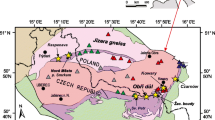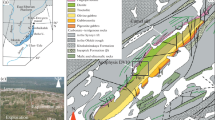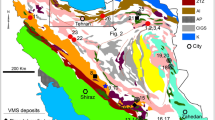Abstract
Recent investigations have made it possible to update the mineralogical, petrochemical, and geochemical characteristics of anorthosites, which are considered the main link and main PGE and Au concentrator in low-sulfide PGM mineralization localized in a specific taxitic horizon (Reef I) of the Yoko–Dovyren massif. The recognized compositional and structural features of this horizon suggest that the anorthosites formed as a result of not only magmatic processes proper, but also late magmatic and postmagmatic processes with extremely high volatile-component activity. The origin of this horizon can be explained by the “compaction” hypothesis and thermal shrinking phenomenon. Zones of weakness up to fractures and cavities formed at the interface of rocks with contrasting compositions and properties while they cooled. Due to the decompression effect, these zones “sucked in” the interstitial leucocratic melt and the volatiles squeezed out of the massif’s deeper horizons. The established trends of variation in mineral composition—Pl (82–88% An); Ol (78–81% Fo); Cpx (40–44% En, 9–18% Fs, and 41–47% Wo); and Opx (74–78% En, 16–24% Fs, and 2–5% Wo)—suggest fractional crystallization of the residual liquor. Fluid–magma interaction processes led to the significant heterogeneity of anorthosites and other rocks, the formation of nonequilibrium mineral assemblages, and the concentration of ore-bearing components. The sulfide assemblages were viewed as products of the subsolidus transformation of solid solutions (mss and iss + poss) that formed during the crystallization of a Cu-rich immiscible sulfide fluid. It was demonstrated that noble metals were associated not only with the limited volume of the sulfide fluid. The bulk of the noble metals with “crustal” components (Sn, Pb, Hg, Bi, As, Sb, Te, S, etc.) were supplied to anorthosite cavities together with volatile components and chlorine, and this accounts for the abundance of platinoid minerals among the other forms of platinoid occurrence. The leading role of reduced gases (H2, CH4, and CO), H2O, and Cl has been established in the genesis of noble metal minerals.















Similar content being viewed by others
REFERENCES
Ariskin, A.A., Kostitsyn, Yu.A., Konnikov, E.G., Danyushevsky, L.V., Meffre, S., Nikolaev, G.S., Mak-Nil E., Kislov, E.V., and Orsoev, D.A., Geochronology of the Dovyren intrusive complex, northwestern Baikal Area, Russia, in the Neoproterozoic, Geochem. Int., 2013, vol. 51, no. 11, pp. 859–875.
Ariskin, A.A., Danyushevsky, L.V., Bychkov, K.A., McNeill, A.W., Barmina, G.S., and Nikolaev, G.S., Modeling solubility of Fe–Ni sulfides in basaltic magmas: the effect of Ni in the melt, Econ. Geol., 2013, vol. 108, pp. 1983–2003.
Ariskin, A.A., Kislov, E.V., Danyushevsky, L.V., Nikolaev, G.S., Fiorentini, M., Gilbert, S., Goemann, K., and Malyshev, A.V., Cu–Ni–PGE fertility of the Yoko-Fovyren layered massif (northern Transbaikalia, Russia): thermodynamic modeling of sulfide compositions in low mineralized dunite based on quantitative sulfide mineralogy, Mineral. Deposita, 2016, vol. 51, pp. 993–1011.
Ariskin, A.A., Danyushevsky, L.V., Nikolaev, G.S., Kislov, E.V., Fiorentini, M., McNeill, A.W., Kostitsyn, Y.A., Goemann, K., Feig, S.T., and Malyshev, A.V., The Dovyren intrusive complex (southern Diberia, Russia): insights into dynamics of an open magma chamber with implications for parental magma origin, composition, and Cu–Ni–PGE fertility, Lithos, 2018, vol. 302–303, pp. 242–262.
Arndt, N.T., Lesher, C.M., and Czamanske, G.K., Mantle-derived magmas and magmatic Ni–Cu–(PGE) deposits, Econ. Geol., 2005, vol. 100, pp. 5–24.
Ballhaus, C.G. and Stumplf, E.F., Sulfide and platinum mineralization in the Merensky reef: evidence from hydrous silicates and fluid inclusions, Contrib. Mineral. Petrol., 1986, vol. 94, pp. 193–204.
Balykin, P.A., Yurkovskii, S.A., and Proskuryakov, A.A., On problem of assessment of gaseous component of the intrusive basic rocks, Geol. Geofiz., 1983, no. 12, pp. 36–42.
Barnes, S.-J., Naldrett, A.J., and Gorton, M.P., The origin of the fractionation of platinum-group elements in terrestrial magmas, Chem. Geol., 1985, vol. 53, p. 303–323.
Barnes, S.-J. and Naldrett, A.J., Geochemistry of the J-M (Howland) reef of the Stillwater Complex, Minneapolis adit area. I. Sulfide chemistry and sulfide–olivine equilibrium, Econ. Geol., 1986, vol. 81, pp. 199–203.
Barnes, S.J. and Campbell, J.H., Role of late magmatic fluids in Merensky type platinum deposits, Geology, 1988, vol. 16, pp. 488–491.
Barnes, S.J. and Lightfoot, P.C., Formation of magmatic nickel-sulfide ore deposits and processes affecting their copper and platinum-group element contents, Econ. Geol., 2005, vol. 100, pp. 179–213.
Blagorodnometal’naya mineralizatsiya v rassloennykh ul’trabazit-bazitovykh massivakh yuga Sibirskoi platform (Noble Metal Mineralization in Layered Ultramafic–Mafic Massifs of the Southern Siberian platform), Tolstykh., N.D., Orsoev, D.A., Krivenko, A.P., and Izokh, A.E., Eds., Novosibirsk: Parallel’, 2008.
Boudreau, A.E., Mathez, E.A., and McCallum, I.S., The halogen geochemistry of the Stillwater and Bushveld complexes: evidence for transport of the platinum-group elements by Cl-rich fluids, J. Petrol., 1986, vol. 27, p. 967–987.
Boudreau, A.E. and McCallum, I.S., Concentration of PGE by magmatic fluids in layered intrusions, Econ. Geol., 1992, vol. 87, p. 1830–1849.
Boudreau, A.E., Transport of the platinum-group elements by igneous fluids in layered intrusions, New Developments in Magmatic Ni–Cu and PGE Deposits, Li, C. and Ripley, E.M., Eds., Beijing: Geological Publishing House, 2009, pp. 229–249.
Cabri, L.J., New data on phase relations in the Cu–Fe–S system, Econ. Geol., 1973, vol. 68, pp. 443–454.
Campbell, I.H., Naldrett, A.J., and Barnes, S.-J., A model for the origin of platinum-rich sulfide horizons in the Bushveld and Stillwater complexes, J. Petrol., 1983, vol. 24, pp. 133–165.
Dick, H.J.B. and Bullen, T., Chromian spinel as a petrogenetic indicator in abyssal and alpine-type peridotites and spatially associated lavas, Contrib. Mineral. Petrol., 1984, vol. 86, pp. 54–76.
Distler, V.V., Dyuzhikov, O.A., Kravtsov, V.F., Sluzhenikin, S.F., and Turovtsev, D.M., Low-sulfide PGM formation of the Norilsk district, Geologiya i genezis mestorozhdenii platinovykh metallov (Geology and Genesis of the PGM Deposits), Moscow: Nauka, 1994, pp. 48–65.
Distler, V.V. and Stepin, A.G., Low-sulfide PGE-bearing horizon of the Ioko-Dovyren layered ultramafic–mafic intrusion, Northern Baikal region, Dokl. Ross. Akad. Nauk, 1993, vol. 328, no. 4, pp. 498–501.
Dodin, D.A., Chernyshov, N.M., and Yatskevich, B.A., Platinometal’nye mestorozhdeniya Rossii (PGM Deposits of Russia), St. Petersburg: Nauka, 2000.
Engelbrecht, J.P., Chromites of the Bushveld complex in the Nietverdiend area, Econ. Geol., 1985, vol. 80, pp. 729–746.
Ernst R.E. and Hamilton, M.A., U-Pb baddeleyite age of 725 Ma of the Dovyren intrusion, Siberia: correlation with a giant 723-Ma Franklin magmatic province of Nortern Laurentia, Geologiya polyarnykh oblastei Zemli. Materialy XLII Tektonicheskogo soveshchaniya (Geology of Polar Regions of the Earth. Proc. 42nd Tectonic conference), Moscow: GEOS, 2009, vol. 2, pp. 330–332.
Feoktistov, G.D., Fluid mode of the formation of the Siberian traps, Flyuidnyi rezhim formirovaniya mantiinykh porod (Fluid Mode of the Formation of Mantle Rocks), Novosibirsk: Nauka, 1980, pp. 81–124.
Fleet, M.E., Tronnes, R.G., and Stone, W.E., Partitioning of platinum-group elements (Os, Ir, Ru, Pt, Pd) and gold between sulfide liquid and basalt melt, Geochim. Cosmochim. Acta, 1996, vol. 60, pp. 2397–2412.
Flyuidnyi rezhim formirovaniya mantiinykh porod (Fluid Mode of the Formation of Mantle Rocks), Feoktistov, G.D., Ostafiichuk, I.M., Kiselev, A.I., and Kharin, G.S., Novosibirsk: Nauka, 1980.
Geologiya, petrogeokhimiya i khromitonosnost' gabbro-giperbazitovykh massivov Yuzhnogo Urala (Geology, Petrogeochemistry, and Chromite Potential of the Gabbro–Hyperbasite Massifs of the South Urals), Savel’ev, D.E., Snachev, V.I., Savel’eva, E.N., and Bazhin, E.A., Eds., Ufa: DizainPoligrafServis, 2008.
Glotov, A.I., Kislov, E.V., Orsoev, D.A, Podlipskii, M.Yu., Pertseva, A.P., and Zyuzin, V.I., Geochemistry of sulfur isotopes in different types of sulfide mineralization of the Ioko-Dovyren massif, Northern Baikal region, Geol. Geofiz., 1998, vol. 39, no. 2, pp. 228–233.
Gongalsky, B.I. and Krivolutskaya, N.A., World-Class Mineral Deposits of Northeastern Transbaikalia, Siberia, Russia, Springer, 2019.
Gorbachev, N.S., Naldrett, A., Brugmann, G., Khodorevskaya, L.I., and Azif, M., Experimental study of PGE and gold distribution between aqueous–chloride fluid and basaltic melt at T = 1100–1350°C and P = 5 kbar, Dokl. Akad. Nauk, 1994, vol. 335, no. 3, pp. 356–358.
Grokhovskaya, T.L., Distler, V.V., Klyunin, S.F., Zakharov, A.A., and Laputina, I.P., Low-sulfide PGE mineralziaiton of the Lukkulaisvaara massif, North Karelia, Geol. Rud. Mestorozhd., 1992, no. 2, pp. 32–50.
Halkoaho, T., The Sompujarvi and Ala-Penikka PGE Reefs in the Penikat layered intrusion, Northern Finland: implications for PGE reef-forming processes, Acta Universitatis Ouluens, 1994, A249.
Hanley, J.J., Mungall, J.E., Pettke, T., Spooner, E.T.C., and Bray, C.J., Fluid and halide melt inclusions of magmatic origin in the ultramafic and lower banded series, Stillwater complex, Montana, USA, J. Petrol., 2008, vol. 49, p. 1133–1160.
Kazanov, O.V., Abundance of platinum and palladium and problem of mass balance of low-sulfide PGM mineralization, Obrazovanie i lokalizatsiya rud v zemnoi kore (Ore Formation and Localization in the Earth’s Crust), St. Petersburg: St-Petersb. Univ., 1999, pp. 244–254.
Kolonin, G.R., Orsoev, D.A., Sinyakova, E.F., and Kislov, E.V., The Ni/Fe ratio in pentlandite as an indicator of sulfur fugacity during the formation of PGE-bearing sulfide mineralization of the Ioko–Dovyren Massif, Dokl. Earth Sci., 2000, vol. 370, no. 1, pp. 75–79.
Konev, A.A. and Bekman, I.K., On the origin of gases released at heating of rocks and minerals, Geol. Geofiz., 1978, no. 12, pp. 33–39.
Konnikov E.G., Prasolov E.M., Tokarev I.V, Kislov E.V., and Orsoev, D.A., Ar and Ne isotopes from rocks of the Dovyren mafic–ultramafic rocks, Geol. Geofiz., 2002, vol. 43, no. 6, pp. 543–552.
Konnikov, E.G., Meurer, W.P., Neruchev, S.S., Prasolov, E.M., Kislov, E.V., and Orsoev, D.A., Fluid regime of the platinum group elements (PGE) and gold-bearing reef formation in the Dovyren mafic-ultramafic layered complex, Eastern Siberia, Russia, Mineral. Deposita, 2000, vol. 35, no. 6, p. 526–532.
Makovicky, E., Ternary and Quaternary phase systems with PGE, The Geology, Geochemistry, Mineralogy and Mineral beneficiation of Platinum-Group Elements, Cabri, L.J., Ed., Canad. Inst. Mining, Metall., Petrol., 2002, vol. 54, pp. 131–175.
McDonough, W.F. and Sun, S.-S., The composition of the Earth, Chem. Geol., 1995, vol. 120, p. 223–253.
Med’-nikelenosnye gabbroidnye formatsii skladchatykh oblastei Sibiri (Copper–Nickel-bearing Gabbroid Formations of Siberian Fold Areas), Krivenko, A.P., Glotov, A.I., Balykin, P.A., Gabysheva, G.A., Shcheka, S.A., Konnikov, E.G., Pyatov, O.I., and Kolotilov. L.I., Novosibirsk: Nauka, 1990.
Merkle, R.K.W. and Von Gruenewaldt, G., Compositional variation of Co-rich pentlandite: relation to the evolution of the upper zone of the Western Bushveld Complex, South Africa, Can. Mineral., 1986, vol. 24, p. 529–546.
Meurer, W.P. and Boudreau, A.E., Compaction of density stratified cumulates: effect on trapped-liquid distributions, J. Geol., 1996, vol. 104, p. 115–120.
Mungall, J.E. and Brenan, J.M., Partitioning of platinum-group elements and au between sulfide liquid and basalt and the origins of mantle-crust fractionation of the chalcophile elements, Geochim. Cosmochim. Acta, 2014, vol. 125, pp. 265–289.
Naldrett, A.J., Platinum-group element deposits, Platinum Group Elements: Mineralogy, Geology, Recovery, Canad. Inst. Min. Metall., 1981, vol. 23, pp. 197–231.
Naldrett, A.J. Magmaticheskie sul’fidnye mestorozhdeniya medno-nikelevykh i platinometal’nykh rud (Magmatic Sulfide Copper–Nickel and PGM Ores), St-Petersburg: Izd-vo SPbGU, 2003.
Naldrett, A.J., Fundamentals of magmatic sulfide deposits, Rev. Econ. Geol., 2011, vol. 17, pp. 1–50.
Neimark, L.A., Larin, A.M., Yakovleva, S.Z., Sryvtsev, N.A., and Buldygerov, V.V., New age data on the rocks of the Baikal–Patom fold area: evidence from U-Pb zircon dating, Dokl. Akad. Nauk SSSR, 1991, vol. 320, no. 1, pp. 182–186.
Neruchev, S.S. and Prasolov, E.M., Fluid-geochemical model of PGE deposits related to trap magmatism, Platina Rossii (Russia’s Platinum), M.: Geoinformmark, 1995, vol. 2, pt. 1, pp. 94–101.
Orsoev, D.A., Kislov, E.V., Konnikov, E.G., Kanakin, S.V., and Kulikova, A.B., Distribution and compositional peculiarities of the PGE-bearing horizons of the Ioko-Dovyren layered massif (Northern Baikal region), Dokl. Earth Sci., 1995, vol. 340, no. 3, pp. 225–228.
Orsoev, D.A., Konnikov, E.G., Kislov, E.V., Zaguzin, G.N., and Kanakin, S.V., Low-sulfide PGE mineralization of the lower critical zone of the Ioko-Dovyren layered pluton, Northern Baikal region, Russia, Tez. dokl. VII Mezhd. platin. simpozium (Proc. 7th Intern. Platinum Symposium), Moscow, 1994, pp. 82–83.
Orsoev, D.A., Konnikov, E.G., Glotov, A.I, and Kislov, E.V., Lower layered horizon of the Fededorova Pana gabbroid massif (Kola Peninsula): structure, composition, and distribution of fluid phase, Geol. Geofiz., 1997, no. 11, pp. 1782–1791.
Orsoev, D.A., Rudashevsky, N.S., Kretser, Yu.L., and Konnikov, E.G., Precious metal mineralization in low-sulfide ores of the Ioko–Dovyren layered massif, northern Baikal Region, Dokl. Earth Sci., 2003, vol. 390, no. 2, pp. 545–549.
Peregoedova, A. and Ohnenstetter, M., Collectors of Pt, Pd and Rh in an S-poor Fe–Ni–Cu-sulfide system at 760°C: experimental data and application to PGE deposits, Can. Mineral., 2002, vol. 40, pp. 527–561.
Plaksenko, A.N., Tipomorfizm aktsessornykh khromshpinelidov ul’tramafit-mafitovykh magmaticheskikh formatsii (Typomorphism of Accessory Cr-spinels of Ultramafic–Mafic Formations), Voronezh: Izd-vo VGU, 1989.
Proterozoiskie ul’trabazit-bazitovye formatsii Baikalo-Stanovoi oblasti (Proterozoic Ultramafic–Mafic Formations of the Baikal–Stanovoi Area), Balykin, P.A., Polyakov, G.V., Bognibov, V.I., and Petrova, T.E., Eds., Novosibirsk: Nauka, 1986.
Pushkarev, E.V., Votyakov, S.L., Chashchukhin, I.S., Kislov, E.V., Shchapova, Yu.V., and Galakhova, O.L., Ore Cr-spinels of the Ioko-Dovyren layered massif (Northern Baikal Region): composition, structural features, and conditions of formation, Ezhegodnik-2002 (Yearbook-2002), Yekaterinburg: Inst. Geol. Geokhim. UrO RAN, 2003, pp. 215–223.
Roeder, P.L., Chromite: from the Fiery Rain of chondrules to the Kilauea Iki lava lake, Can. Mineral., 1994, vol. 32, p. 729–746.
Ryabov, V.V., Flyuidnyi rezhim trappovogo magmatizma i rudoobrazovaniya (petrologicheskii aspekt) (Fluid Mode of Trap Magmatism and Ore Formation: Petrological Aspect), Geol. Geofiz., 1999, no. 10, pp. 1457–1473.
Seyler, M., Lorand, J.P., Dick, H.J.B., and Drouin, M., Pervasive melt percolation reactions in ultra-depleted refractory harzburgites at the Mid-Atlantic Ridge, 15 degrees 15°20′ N: ODP Hole 1274a, Contrib. Mineral. Petrol., 2007, vol. 153, p. 303–319.
Sharkov, E.V., Formirovanie rassloennykh intruzivov i svyazannogo s nimi orudeneniya (Formation of Layered Intrusions and Related Mineralization), Moscow: Nauchnyi mir, 2006.
Sharpe, M.R. and Hulvert, L.J., Ultramafic sills beneath the eastern Bushveld Complex, Econ. Geol., 1985, vol. 80, p. 849–871.
Shinkarev, N.F., and Grigor’eva, L.V., Transportation of deep matter and ore fluids, Zap. Mineral. O-va, 1983, vol. 112, no. 1, pp. 28–41.
Simonov, V.A. and Izokh, A.E., Relationship of volatile components and noble metals in the layered ultramafic–mafic massifs, Termobarogeokhimiya mineraloobrazuyushchikh protsessov (Thermobarogeochemistry of Mineral-Forming Processes), Novosibirsk: Izd-vo OIGGiM, 1994, pp. 117–133.
Sluzhenikin, S.F., Distler, V.V., Dyuzhikov, O.A., Kravtsov, V.F., Kunilov, V.E., Laputina, I.P., and Turovtsev, D.M., Low-sulfide PGE mineralization in the Norilsk differentiated intrusions, Geol. Rud. Mestorozhd., 1994, no. 3, pp. 195–217.
Spiridonov, E.M., Orsoev, D.A., Ariskin, A.A., Nikolaev, G.S., Kislov, E.V., Korotaeva, N.N., and Yaposkurt, V.O., Hg- and Cd-bearing Pd, Pt, Au, and Ag minerals in sulfide-bearing mafic and ultramafic rocks of the Yoko-Dovyren intrusion in the Baikalides of the northern Baikal Area, Geochem. Int., 2019a, vol. 57, no. 1, pp. 42–55.
Spiridonov, E.M., Orsoev, D.A., Ariskin, A.A., Kislov, E.V., Korotaeva, N.N., Nikolaev, G.S., and Yapaskurt, V.O., Palladogermanide Pd2Ge of sulfide-bearing anorthosites of the Ioko-Dovyren intrusion: first finding in Russia, Dokl. Akad. Nauk 2019b (in press).
Sugaki, A. and Kitakaze, A., High form pentlandite and its thermal stability, Am. Mineral., 1998, vol. 83, p. 133.
Wenzel, T., Baumgartner, L.P., Bruegman, G.E., Konnikov, E.G., and Kislov, E.V., Partial melting and assimilation of dolomitic xenoliths by mafic magma: Ioko–Dovyren intrusion (north Baikal Region, Russia), J. Petrol, 2002, vol. 43, no. 11, p. 2049.
Yakovlev, Yu.N. and Dokuchaeva, V.S., PGM mineralization of the Monchegorsk pluton (Kola Peninsula), Geologiya i genezis mestorozhdenii platinovykh metallov (Geology and Genesis of PGM deposits), Moscow: Nauka, 1994, pp. 79–86.
ACKNOWLEDGMENTS
The author thanks the analysts at the Laboratory of Instrumental Methods of Analysis (Geological Institute, Siberian Branch, Russian Academy of Sciences, Ulan-Ude) for analytical work and, personally, S.V. Kanakin and E.V. Khodyreva (scanning electron microscopy, microprobe) and B.Zh. Zhalsaraev (X-ray fluorescence analysis). The author is sincerely grateful to E.G. Konnikov, on whose initiative and under whose supervision the studies at the Yoko–Dovyren massif were first performed, and to A.V. Lavrenchuk, A.I. Glotov, A.S. Mekhonoshin, T. Ventsel’, L.P. Baumgartner, R.A. Badmatsyrenova, A.A. Tsygankov, T.T. Vrublevskaya, E.S. Persikov, A.A. Ariskin, E.V. Kislov, L.V. Danyushevkii, G.S. Nikolaev, and D.S. Kamenetskii, who took part in fieldwork in various years. Thanks also are due to E.M. Spiridonov for assistance in joint studies and to the reviewers for constructive remarks, which improved the quality of the presented materials and their interpretation.
Funding
This work was supported by the Geological Institute, Siberian Branch, Russian Academy of Sciences, basic research project no. 0340-2018-0007, and partially by the Russian Foundation for Basic Research, project no. 18-45-030016 r a.
Author information
Authors and Affiliations
Corresponding author
Ethics declarations
The authors declare that they have no conflict of interest.
Additional information
Translated by E. Murashova
Rights and permissions
About this article
Cite this article
Orsoev, D.A. Anorthosites of the Low-sulfide Platiniferous Horizon (Reef I) in the Upper Riphean Yoko–Dovyren Massif (Northern Cisbaikalia): New Data on the Composition, PGE–Cu–Ni Mineralization, Fluid Regime, and Formation Conditions. Geol. Ore Deposits 61, 306–332 (2019). https://doi.org/10.1134/S1075701519040044
Received:
Revised:
Accepted:
Published:
Issue Date:
DOI: https://doi.org/10.1134/S1075701519040044




